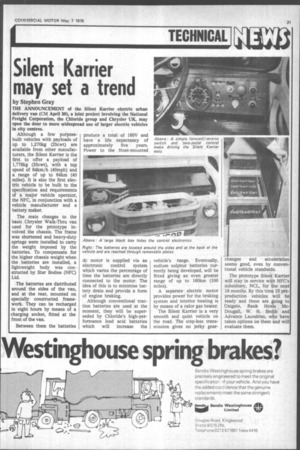Silent Kamer may set a trend
Page 23

If you've noticed an error in this article please click here to report it so we can fix it.
by Stephen Gray
THE ANNOUNCEMENT of the Silent Karrier electric urban delivery van (CM April 30), a joint project involving the National Freight Corporation, the Chloride group and Chrysler UK, may open the door to more widespread use of larger electric vehicles in city centres.
Although a few purposebuilt vehicles with payloads of up to 1,270kg (25cwt) are available from other manufacturers, the Silent Karrier is the first to offer a payload of 1,778kg (35cwt), with a top speed of 64km/h (40mph) and a range of up to 64km (40 miles). It is also the first electric vehicle to be built to the specification and requirements of a major vehicle operator, the NFC, in conjunction with a vehicle manufacturer and a battery maker.
The main changes to the basic Chrysler Walk-Thru van used for the prototype involved the chassis. The frame was shortened and heavy-duty springs were installed to carry the weight imposed by the batteries. To compensate for the higher chassis weight when the batteries are installed, a lightweight body was constructed by Star Bodies (NFC) Ltd.
The batteries are distributed around the sides of the van, and at the rear, mounted on specially constructed framework. They can be recharged in eight hours by means of a charging socket, fitted at the front of the van. dc motor is supplied via an electronic control system which varies the percentage of time the batteries are directly connected to the motor. The idea of this is to minimise battery drain and provide a form of engine braking.
Although conventional traction batteries are used at the moment, they will be superseded by Chloride's high-performance lead acid batteries which will increase the vehicle's range. Eventually, sodium sulphur batteries currently being developed, will be fitted giving an even greater range of up to 160km (100 miles).
A separate electric motor provides power for the braking system and interior heating is by means of a calor gas heater.
The Silent Karrier is a very smooth and quiet vehicle on the road. The step-less transmission gives no jerky gear changes and acceleration seems good, even by conventional vehicle standards.
The prototype Silent Karrier will stay in service with NFC's subsidiary, NCL, for the next 18 months. By this time 15 preproduction vehicles will be ready and these are going to Unigate, Rank Hovis McDougall, W. H. Smith and Advance Laundries, who have taken options on them and will evaluate them.




























































































